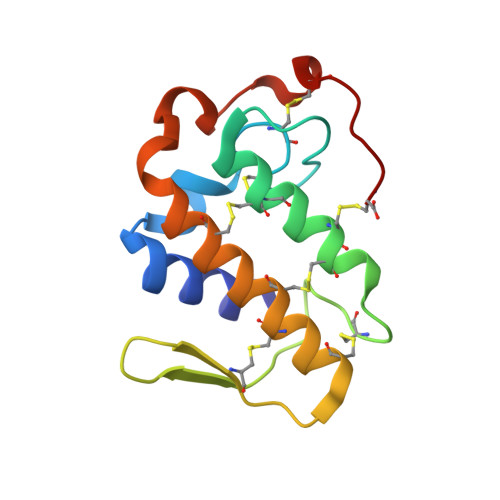Functional and structural studies of a Phospholipase A2-like protein complexed to zinc ions: Insights on its myotoxicity and inhibition mechanism.
Borges, R.J., Cardoso, F.F., Fernandes, C.A., Dreyer, T.R., de Moraes, D.S., Floriano, R.S., Rodrigues-Simioni, L., Fontes, M.R.(2017) Biochim Biophys Acta 1861: 3199-3209
- PubMed: 27531710
- DOI: https://doi.org/10.1016/j.bbagen.2016.08.003
- Primary Citation of Related Structures:
4WTB - PubMed Abstract:
One of the main challenges in snakebite envenomation treatment is the development of stable, versatile and efficient anti-venom therapies. Local myotoxicity in accidents involving snakes from the Bothrops genus is still a consequence of serum therapy inefficient neutralization that may lead to permanent sequelae in their victims. One of the classes of toxins that participate in muscle necrosis is the PLA 2 -like proteins. The aim of this work was to investigate the role of zinc ions in the inhibition of PLA 2 -like proteins and to advance the current knowledge of their action mechanism. Myographic and electrophysiological techniques were used to evaluate the inhibitory effect of zinc ions, isothermal titration calorimetry assays were used to measure the affinity between zinc ions and the toxin and X-ray crystallography was used to reveal details of this interaction. We demonstrated that zinc ions can effectively inhibit the toxin by the interaction with two different sites, which are related to two different mechanism of inhibition: preventing membrane disruption and impairing the toxin state transition. Furthermore, structural study presented here included an additional step in the current myotoxic mechanism improving the comprehension of the allosteric transition that PLA 2 -like proteins undergo to exert their function. Our findings show that zinc ions are inhibitors of PLA 2 -like proteins and suggest two different mechanisms of inhibition for these ions. Zinc is a new candidate that can assist in anti-venom treatments and can promote the design of new and even more accurate structure-based inhibitors for PLA 2 -like proteins.
Organizational Affiliation:
Departamento de Física e Biofísica, Instituto de Biociências, Universidade Estadual Paulista (UNESP), Rua Prof. Dr. Antonio Celso Wagner Zanin, s/n, 18618-689 Botucatu, SP, Brazil.

















